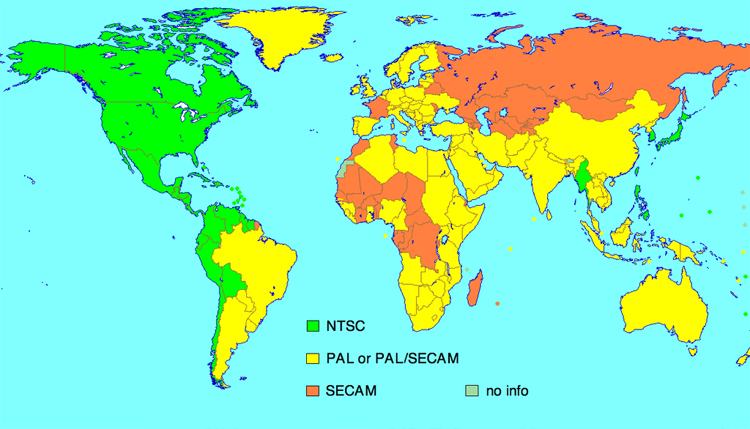International Video Standards Primer
INTERNATIONAL VIDEO STANDARDS: THE BASICS, THE WHY’S, AND THE HOW’S

Analogue videotape was used for many years throughout the world, but there were three primary systems / video standard used in very specific regions, each developed during the early years of television.
NTSC: the defacto standard in North America (Canada, the United States, Mexico, and parts of South America, and Japan).
PAL: the main standard in Europe (England, Germany, parts of Africa and much of Asia).
SECAM: France’s preferred standard, as well as the former Soviet Union, parts of Africa, and some former French colonies.
There were slight variations in some countries and whole regions (ME-SECAM, M-PAL, N-PAL), but the reason for these distinct systems are tied to the different voltages in North America (100 volts / 60 hertz) and Europe (220 volts / 50 hertz), the differences in the way colour was carried in each system, and the video frame rates in North America (30 frames per second) vs. Europe (25 frames per second).
Unless one used a multistandard VCR capable of playing back tapes in the system of one’s own country – common in Europe, Asia, and Africa, much less so in North America – the results were gibberish, hence a need to use a combination multistandard VCR and / or a standard conversion device which retain the best possible picture as, for example, a British PAL VHS tape was played on a multistandard or PAL VCR,and its signal converted to the North American NTSC format and recorded on a North American VCR.
The original tape isn’t physically altered; only the audio & video being played is converted so the new NTSC videotape is playable on any North American VCR.
The process is almost identical when recording onto a North American DVD: as the PAL tape is played and its signal is converted, instead of a VCR, the audio & video is recorded to DVD. Note: as a carry-over from videotape, North American DVDs are still in NTSC (and classified as Region 1); European DVDs are PAL (classified as Region 2); and certain Asian and African countries have their own Region Code (ranging from 3 to 8).
In the case of DVD, Region coding exists less to preserve PAL and NTSC formats, but to restrict sale of certain titles and ensure a movie bought in one country would risk potential sales of the rights holder in another, or enable someone to watch a movie at home when it has yet to be released in cinemas in their country.
It’s an oversimplification, but certainly in the cases of PAL and SECAM, these systems mandate playing the original recording on the proper VCR and converting the audio and video to NTSC for viewing in Canada on DVD.
For digitizing videotapes, it is possible to create a digital file that retains the elements of an original PAL recording, as well as an original NTSC recording.
Not sure what type of videotapes you have? Here’s a Primer on the best-known legacy formats.
